Tiny algae living in soils could help farmers fight climate change by capturing and storing carbon dioxide, according to researchers.
A review published in the journal Agriculture outlined how edaphic microalgae – microscopic algae that live in soils – could help capture and lock away carbon dioxide more effectively than many existing land management strategies.
Scientists suggest that using algae-based inoculants could increase the amount of carbon stored in fields, offering a practical tool for farmers aiming to boost soil health while contributing to climate mitigation.
Agricultural soils typically hold 25–75% less organic carbon than undisturbed ecosystems, leaving a major opportunity to rebuild that carbon bank. Researchers estimate that restoring soil carbon globally could sequester 50–100 petagrams of carbon by the end of the century – enough to significantly reduce atmospheric CO₂ levels.
But getting carbon back into the soil is not straightforward. Many current approaches, from reduced tillage to cover crops, can slow carbon loss, but they don’t always guarantee stable long-term storage. This is where scientists believe algae may come in.
Soil health and carbon storage booster
Microalgae are already well known in aquaculture, animal feed and biofuel sectors, but their role in soil has received less attention, the review’s authors, from Széchenyi István University in Hungary, explained.
Soil algae make up around 27% of microbial biomass in agricultural land and already capture about 3.6 gigatonnes of carbon annually worldwide.
Unlike many other soil microbes, algae photosynthesise, directly drawing down CO₂ and converting it into organic compounds. Some species can fix carbon 10 to 50 times more efficiently than terrestrial plants.
When algae die, their residues — known as necromass — can form stable complexes with minerals in the soil, keeping carbon locked away for decades or even centuries.
Algae also release sticky polysaccharides that bind soil particles together, improving soil aggregation and protecting organic matter from rapid decomposition.
In trials with maize and wheat, inoculating soil with cyanobacteria (photosynthetic microorganisms often referred to as “blue-green algae”) such as Nostoc and Anabaena improved soil structure, increased microbial biomass carbon, and even boosted crop yields.
What are soil inoculants?
Soil inoculants are live microorganisms — such as bacteria, fungi, or algae — deliberately added to soils or seeds to improve soil function and crop performance. They can act as biofertilisers, enhancing nutrient uptake, or as biopesticides, helping protect plants against pests and diseases. Algal inoculants add the extra dimension of capturing and storing carbon.
Added benefits
The concept of microbial inoculants is not new – biofertilisers based on bacteria and fungi are already widely studied. But what makes algae different is their dual role as both a carbon sink and a soil health booster, the researchers said.
Alongside sequestering CO₂, algal inoculants can improve nutrient availability, particularly phosphorus and micronutrients like iron and zinc, and stimulate plant growth through natural hormones.
They can also help crops tolerate stresses such as drought or salinity, and reduce reliance on synthetic fertilisers and pesticides.
Barriers and opportunities
Despite the promise, large-scale use of algal inoculants in field conditions is still limited, the review said. Most studies so far have been confined to pots or controlled environments, and results vary depending on soil type, climate, and algal strain. Commercial inoculant development has so far focused on yield gains rather than carbon sequestration.
The researchers argue that more field research and product development are urgently needed – including exploring biochar-based algal formulations that could further stabilise carbon in soils.
Advances in genetic engineering may also make it possible to breed algae with enhanced photosynthetic efficiency or stress tolerance.
For producers, algae-based inoculants could become another tool in the regenerative agriculture toolbox, complementing cover crops, organic amendments, and precision nutrient management.
Importantly, they could create a pathway for farmers to participate in future carbon markets, where payments for verified soil carbon sequestration are expected to grow, the researchers said.
Key takeaways
- Soil algae (including cyanobacteria) are emerging as living inoculants that can help farms sequester carbon while improving soil function.
- They photosynthesise, add organic compounds to the soil, and produce sticky extracellular polysaccharides that strengthen aggregation and protect soil organic carbon.
- Trials report gains in microbial biomass carbon and better soil stability, with potential knock-on benefits for nutrient availability and crop resilience.
- Field-scale validation and product development are still early; biochar-based formulations and strain selection are key R&D areas.
- For producers, algae inoculants would complement cover crops, reduced tillage and organic amendments—not replace them.











